Rosalea Barker: Hurricane Lane Misses Hawai'i
Not Like A Hurricane
First published on WerewolfHawai'i scares
itself sick, over a no-show storm
by Rosalea
Barker
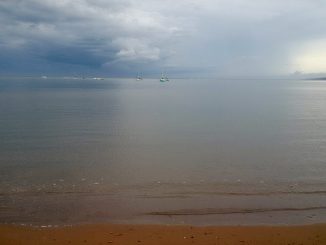 The past week has been mind-torture
here in Kaunakakai on the South Central coast of Moloka‘i,
with the past three days (Wednesday to Friday) being
equivalent to the proverbial month of Sundays as facilities
and stores closed in anticipation of the damaging effects of
Hurricane Lane. While news outlets understandably focused on
dramatic scenes of crashing surf and gushing waters in
swollen rivers and streams on the Big Island, the reality
for us here was quite the opposite, as the Turner-esque
scene of millpond and clouds down at the harbor on Friday
afternoon attests.
The past week has been mind-torture
here in Kaunakakai on the South Central coast of Moloka‘i,
with the past three days (Wednesday to Friday) being
equivalent to the proverbial month of Sundays as facilities
and stores closed in anticipation of the damaging effects of
Hurricane Lane. While news outlets understandably focused on
dramatic scenes of crashing surf and gushing waters in
swollen rivers and streams on the Big Island, the reality
for us here was quite the opposite, as the Turner-esque
scene of millpond and clouds down at the harbor on Friday
afternoon attests.
Granted, that photo was taken after Hurricane Lane had been downgraded to a tropical storm but at no point did the sea here get any more dramatic than “choppy” nor did the winds down in town amount to anything more than what we occasionally get anyway. Rain in Kaunakakai? Once or twice a few drops would squeeze out of the sky. The most rain fell overnight on Friday into Saturday morning, and even then it wasn’t a downpour. Because South Central is so dry—we haven’t had rain for several months—it was regarded as a prayer answered.
That’s not to say that other parts of the island didn’t experience high winds and rain—even a power outage for the entire East End of the island—but, again, it was nothing more than we’ve experienced before. In fact, a couple of months ago, the entire island was blacked out because a random wind gust blew a sheet of roofing iron someone was taking to the rubbish tip off the back of their pickup and onto high-voltage power lines, triggering an automatic shutdown of a crucial part of the power distribution system. It was many hours before the power was restored—12 hours for some—but while it lasted, the outage gave us all plenty of time to realize what we might need to have on hand to deal with, say, a hurricane.
The warnings and what they wrought
The weekend prior to Lane getting closest to the islands, I was on O‘ahu and a bit worried about whether my Monday flight back to Moloka‘i would be cancelled due to weather conditions. At that point, Lane was progressing at about 15 mph, but was still hundreds of miles to the south. Rationally, there was little likelihood of the conditions over the Kai‘iwi Channel between the two islands being affected, but the warnings were out that the hurricane was potentially catastrophic and it could speed up. The flight was a smooth ride, and I needn’t have worried. However, by now, the public imagination was transfixed by worst-case scenarios and the tone was set at a very high pitch of anxiety.
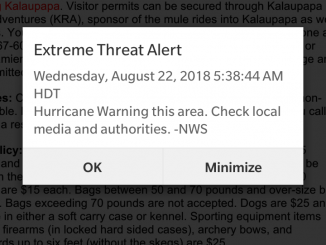 On Tuesday,
Governor Ige signed an emergency proclamation in
anticipation of the hurricane, and in his Twitter post said:
“Never seen such dramatic changes in the forecast track as
with Hurricane Lane.” All bets were off, it seemed. Any
crazy, catastrophic thing might happen at any time. Even a
cynic like me—fully aware that Ige is up for re-election
in November and would be as mindful of how his handling of
the imminent disaster would affect that, as he was concerned
for public safety—started to get rattled.
On Tuesday,
Governor Ige signed an emergency proclamation in
anticipation of the hurricane, and in his Twitter post said:
“Never seen such dramatic changes in the forecast track as
with Hurricane Lane.” All bets were off, it seemed. Any
crazy, catastrophic thing might happen at any time. Even a
cynic like me—fully aware that Ige is up for re-election
in November and would be as mindful of how his handling of
the imminent disaster would affect that, as he was concerned
for public safety—started to get rattled.
Then came the Wednesday 5:40am Extreme Threat Alert from the National Weather Service. These text warnings on your phone come with a sound like a klaxon. I happened to be already awake, but plenty of people were jolted out their sleep and it must have seemed like disaster was imminent. Why else send such a loud warning? We’d all had experience of a similar alert in January—about the incoming ballistic missile—and that had been urgent. (Only not.) This turned out to be an “only not just right now” mass scare event that nonetheless caused one very real concern for someone I spoke with in town hours later that morning.
I had gone into her store to ask if she had the contact information of the person who delivers newspapers on the island. She told me she couldn’t use her phone because of the hurricane. Puzzled, I thought that cell towers must have been affected in some way, even though the weather was perfectly calm. Not so. She had a flip phone, and the text alert took up the entire small screen and she didn’t know that she had to dismiss it, or how to. Until she did, she couldn’t dial out. We’re talking at least five hours here where she couldn’t use her phone during what could well have been an actual emergency.
Sanctuaries lost and founded
 I have two
sanctuaries from the oppressive heat here in
Kaunakakai—the swimming pool and the public library.
Because all state facilities were closed from Wednesday
onwards, I lost the library, and the closure of county-run
facilities from Thursday on meant I lost the swimming pool
as well. The photograph, taken early Wednesday morning in
the park between the library and the state office buildings,
shows that it was a lovely calm day, and Thursday was
similar. I don’t begrudge these closures—they seemed
necessary given the uncertainty of the path and speed of
Lane at that time, as it intensified to a Category 5
hurricane. Neither State nor County would want to be left
open to the inevitable lawsuits that would arise if such
steps hadn’t been taken and there had been disastrous
consequences.
I have two
sanctuaries from the oppressive heat here in
Kaunakakai—the swimming pool and the public library.
Because all state facilities were closed from Wednesday
onwards, I lost the library, and the closure of county-run
facilities from Thursday on meant I lost the swimming pool
as well. The photograph, taken early Wednesday morning in
the park between the library and the state office buildings,
shows that it was a lovely calm day, and Thursday was
similar. I don’t begrudge these closures—they seemed
necessary given the uncertainty of the path and speed of
Lane at that time, as it intensified to a Category 5
hurricane. Neither State nor County would want to be left
open to the inevitable lawsuits that would arise if such
steps hadn’t been taken and there had been disastrous
consequences.
Also on Wednesday, the Maui County Emergency Management Agency (MEMA) announced that an evacuation center would open at Moloka‘i High School at 2pm. The bulk of the population on the island lives along the south coast—the very area that would be hit first and hardest by storm events. And the east-west highway is also along the coast, prone to flooding from high seas but, more particularly, from heavy rainfall. The road at the East End has several fords that can—and often do—become impassible, so MEMA advised people living in the areas that might get cut off to go to the evacuation shelter early. The high school is at a much higher elevation. In the end, MEMA reported, 13 people took advantage of that sanctuary.
However, there is an inherent problem with emergency shelters, to do with the fact that they are established and run by the American Red Cross. ARC is notoriously inefficient administratively, and its relationship with the volunteers it relies upon to set up and operate the shelters is often not a happy one. In June, Big Island Now published a letter entitled “Former Red Cross Worker Not Wishing to Volunteer Any Further” detailing one long-time volunteer’s experience with what happened during the early stages of the Kīlauea lava event.
True to form, the Red Cross messed with MEMA, telling them they were opening a second shelter in a school near the East End—which the agency alerted the public to—and then not opening it.
Betting both ways
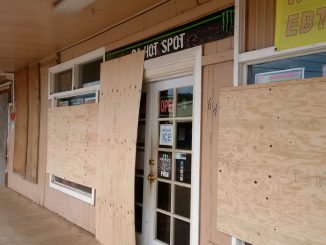 Thursday’s
NOAA prediction showed Lane would be south of Moloka‘i by
2pm on Friday, so some businesses in town began boarding up
or taping over their windows and glass doors and posting
signs that they would be closed until Monday, after the
storm was predicted to pass. A couple of my neighbors also
boarded over their windows, but for a very localized
reason—a third house nearby has a lot of junk in the yard
that could be blown around in high winds. At this time, the
weather was still calm, muggy and oppressive. One shopkeeper
I spoke to said she’d just play it by ear and only close
if it seemed necessary, and several others seemed to have
had the same attitude, judging by the fact that several
businesses were open on Friday.
Thursday’s
NOAA prediction showed Lane would be south of Moloka‘i by
2pm on Friday, so some businesses in town began boarding up
or taping over their windows and glass doors and posting
signs that they would be closed until Monday, after the
storm was predicted to pass. A couple of my neighbors also
boarded over their windows, but for a very localized
reason—a third house nearby has a lot of junk in the yard
that could be blown around in high winds. At this time, the
weather was still calm, muggy and oppressive. One shopkeeper
I spoke to said she’d just play it by ear and only close
if it seemed necessary, and several others seemed to have
had the same attitude, judging by the fact that several
businesses were open on Friday.
Inexplicably, over on O‘ahu, the mayor announced that emergency sirens would be sounded on Thursday at 4pm and asked people to shelter in place. As one commenter said on the mayor’s tweet announcing it: “Cat 3, no direct hit. Sirens?” Of course, it doesn’t require a direct hit to do damage—the winds and rain spin out from the eye of the hurricane for hundreds of miles and are still severe enough at that distance to be catastrophic—but there seems to be little point in scaring the bejeezus out of people, many of whom would be unaware that the siren is just being sounded for…why?
Back here, on my walk home from town on Thursday evening, a woman offered me a ride home in her car. I demurred as I was nearly home anyway, but thanked her and said the words everyone was saying as a farewell greeting last week: “Stay safe.” Well, was I in for a tirade! “There’s no danger. It’s all a big lie! Hurricanes avoid mountains.” “But still,” I said, “there’s flooding and trees down on the Big Island and Maui.” “It’s all a lie! Nothing’s going to happen.” And off she drove.
So, why were we spared?
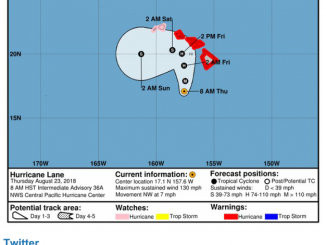 In a sense,
she was perhaps right about hurricanes avoiding mountains.
The reason Lane slowed and broke up so quickly is attributed
by meteorologists to the high-level wind shear that occurred
as it started running parallel to the south of this
mountainous island chain. Maybe the mountains affect the
high-level winds in some way, even though the mountains here
aren’t very high.
In a sense,
she was perhaps right about hurricanes avoiding mountains.
The reason Lane slowed and broke up so quickly is attributed
by meteorologists to the high-level wind shear that occurred
as it started running parallel to the south of this
mountainous island chain. Maybe the mountains affect the
high-level winds in some way, even though the mountains here
aren’t very high.
A different theory is that Lane had a secondary eyewall separated from the primary wall around the eye by a moat. An envirobites article about a research paper on this subject explains: “The primary eyewall generates vortex Rossby waves that travel out to the edge of the hurricane, while the secondary eyewall can generate vortex Rossby waves that travel inward to the hurricane’s center. When two of these waves, traveling in opposite directions, combined in just the right way, the researchers observed wobbles in the simulated hurricanes.”
Understanding the wobble (technically, a trochoidal oscillation) might help meteorologists make better predictions about the path and likely lifespan and intensity of a hurricane.
However, I’d bet dollars to donuts that the good folks of Moloka‘i know the *real* reason Lane gave up the ghost when it got near our part of the archipelago. In pre-European times, Moloka‘i was described as the Island of Powerful Prayers because of priests who lived here and performed some legendary “saves” using prayer alone. While most would attribute this week’s save to Christian prayers instead, the belief that prayer makes an actual difference in what happens in the world—either to individuals or the wider world, including the environment—is very strong here. I have stood quietly in line along with others at a supermarket checkout while a shopper ahead of me put her hand on the checkout operator’s heart and said a prayer for a positive outcome for her upcoming heart surgery.
No doubt, the many New Agers who live on this and other islands performed their own rituals, prayers and visualizations of the hurricane lessening in intensity or going away, and prayers were sent to as many different gods as there are religious adherents in the islands. As for me, I muttered “Go South, young man” 20 times every few minutes at the time of my highest anxiety during this torturous week of having the social media thumbscrews alternately tightened and loosened. A pretty tall order, given that the global torque of hurricanes in the Northern Hemisphere forces them to head north because of a process known as precession.
Nonetheless, it seems to me there is an explanation that fits both the scientific and spiritual explanations—our thoughtwaves went up into the atmosphere and created a secondary eyewall, reducing Lane’s torque to nada and destroying it from within.
Mesmerizing loop of Lane getting torn apart along with some cool transverse banding. (https://t.co/pgySF1s5Ig) pic.twitter.com/4Iki7QRnPq
— Dakota Smith (@weatherdak) August 25, 2018
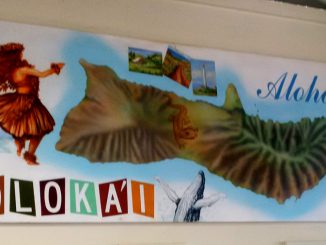


 Ian Powell: Trumpian Health Leadership
Ian Powell: Trumpian Health Leadership Eugene Doyle: Disruption - Historians Challenge Russophobic Propaganda
Eugene Doyle: Disruption - Historians Challenge Russophobic Propaganda Ramzy Baroud: War, Doublethink, And The Struggle For Survival - Geopolitics Of The Gaza Genocide
Ramzy Baroud: War, Doublethink, And The Struggle For Survival - Geopolitics Of The Gaza Genocide Binoy Kampmark: Authoritarian Politics - Netanyahu’s War On Israeli Institutions
Binoy Kampmark: Authoritarian Politics - Netanyahu’s War On Israeli Institutions Keith Rankin: Learning The Correct Lessons From World War Two In Europe
Keith Rankin: Learning The Correct Lessons From World War Two In Europe Ramzy Baroud: Arab Failures - The Unspoken Complicity In Israel's Genocide
Ramzy Baroud: Arab Failures - The Unspoken Complicity In Israel's Genocide